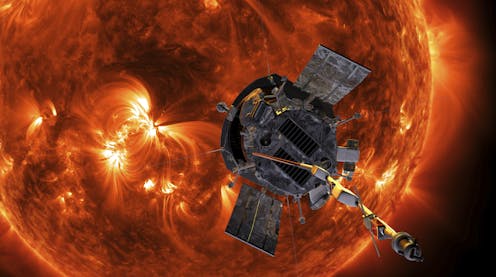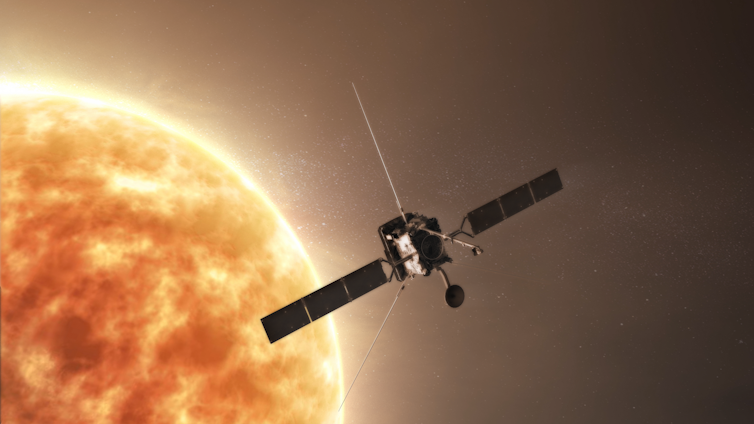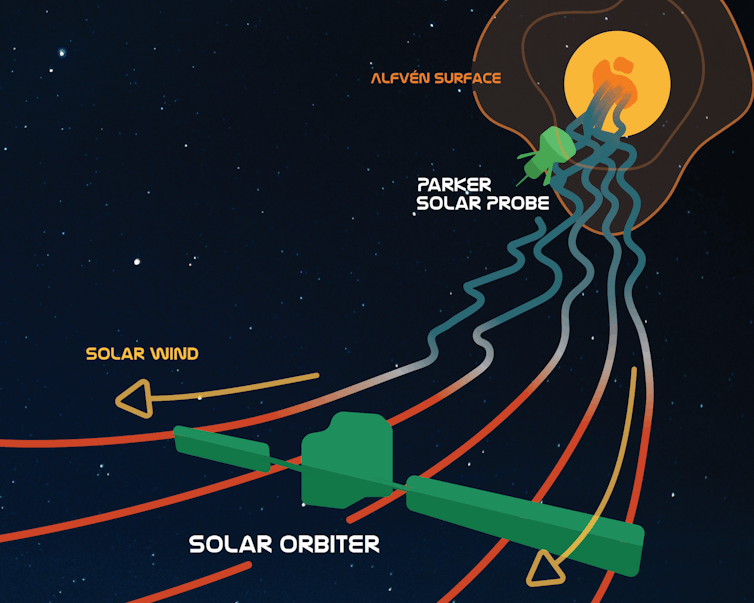2 solar probes are helping researchers understand what phenomenon powers the solar wind
For years, researchers have wondered what energy source allows the solar wind − a projection of charged particles from the Sun − to rush by at hundreds of miles a second.

Our Sun drives a constant outward flow of plasma, or ionized gas, called the solar wind, which envelops our solar system. Outside of Earth’s protective magnetosphere, the fastest solar wind rushes by at speeds of over 310 miles (500 kilometers) per second. But researchers haven’t been able to figure out how the wind gets enough energy to achieve that speed – until now.
Our team of heliophysicists published a paper in August 2024 that points to a new source of energy propelling the solar wind.
Solar wind discovery
Physicist Eugene Parker predicted the solar wind’s existence in 1958. The Mariner spacecraft, headed to Venus, would confirm its existence in 1962.
Since the 1940s, studies had shown that the Sun’s corona, or solar atmosphere, could heat up to very high temperatures – over 2 million degrees Fahrenheit (or more than 1 million degrees Celsius).
Parker’s work suggested that this extreme temperature could create an outward thermal pressure strong enough to overcome gravity and cause the outer layer of the Sun’s atmosphere to escape.
Gaps in solar wind science quickly arose, however, as researchers took more and more detailed measurements of the solar wind near Earth. In particular, they found two problems with the fastest portion of the solar wind.
For one, the solar wind continued to heat up after leaving the hot corona without explanation. And even with this added heat, the fastest wind still didn’t have enough energy for scientists to explain how it was able to accelerate to such high speeds.
Both these observations meant that some extra energy source had to exist beyond Parker’s models.

Alfvén waves
The Sun and its solar wind are plasmas. Plasmas are like gases, but all the particles in plasmas have a charge and respond to magnetic fields.
Similar to how sound waves travel through the air and transport energy on Earth, plasmas have what are called Alfvén waves moving through them. For decades, Alfvén waves had been predicted to affect the solar wind’s dynamics and play an important role in transporting energy in the solar wind.
However, scientists couldn’t tell whether these waves were actually interacting with the solar wind directly or if they generated enough energy to power it. To answer these questions, they’d have to measure the solar wind very close to the Sun.
In 2018 and 2020, NASA and the European Space Agency launched their respective flagship missions: the Parker Solar Probe and the Solar Orbiter. Both missions carried the right instruments to measure Alfvén waves near the Sun.
The Solar Orbiter ventures between 1 astronomical unit, where the Earth is, and 0.3 astronomical units, a little closer to the Sun than Mercury. The Parker Solar Probe dives much deeper. It gets as close as five solar diameters from the Sun, within the outer edges of the corona. Each solar diameter is about 865,000 miles (1,400,000 kilometers).

With both these missions operating together, not only can researchers like us examine the solar wind close to the Sun, but we can also study how it changes between the point where Parker sees it and the point where the Solar Orbiter sees it.
Magnetic switchbacks
In Parker’s first close approach to the Sun, it observed that the solar wind near the Sun was indeed abundant with Alfvén waves.
Scientists used Parker to measure the solar wind’s magnetic field. At some points they noticed the field lines – or lines of magnetic force – waved at such high amplitudes that they briefly reversed direction. Scientists called these phenomena magnetic switchbacks. With Parker, they observed these energy-containing plasma fluctuations everywhere in the near-Sun solar wind.
Our research team wanted to figure out whether these switchbacks contained enough power to accelerate and heat the solar wind as it traveled away from the Sun. We also wanted to examine how the solar wind changed as these switchbacks gave up their energy. That would help us determine whether the switchbacks’ energy was going into heating the wind, accelerating it or both.
To answer these questions, we identified a unique spacecraft configuration where both spacecraft crossed the same portion of solar wind, but at different distances from the Sun.
The switchbacks’ secret
Parker, close to the Sun, observed that about 10% of the solar wind energy was residing in magnetic switchbacks, while Solar Orbiter measured it as less than 1%. This difference means that between Parker and the Solar Orbiter, this wave energy was transferred to other energy forms.
We performed some modeling, much like Eugene Parker had. We built off modern implementations of Parker’s original models and incorporated the influence of the observed wave energy to these original equations.
By comparing both datasets and the models, we could see specifically that this energy contributed to both acceleration and heating. We knew it contributed to acceleration because the wind was faster at Solar Orbiter than Parker. And we knew it contributed to heating, as the wind was hotter at Solar Orbiter than it would have been if the waves weren’t present.
These measurements told us that the energy from the switchbacks was both necessary and sufficient to explain the solar wind’s evolution as it travels away from the Sun.
Not only does our measurement tell scientists about the physics of the solar wind and how the Sun can affect the Earth, but it also may have implications throughout the universe.
Many other stars have stellar winds that carry their material out into space. Understanding the physics of our local star’s solar wind also helps us understand stellar wind in other systems. Learning about stellar wind could tell researchers more about the habitability of exoplanets.
Yeimy J. Rivera receives funding from NASA's Parker Solar Probe project through the SAO/SWEAP subcontract 975569.
Michael L. Stevens receives funding from NASA's Parker Solar Probe project through the SAO/SWEAP subcontract 975569.
Samuel Badman receives funding from NASA's Parker Solar Probe project through the SAO/SWEAP subcontract 975569.
Read These Next
Rural high school students are more likely than city kids to get their diplomas, but they remain les
1 in 5 students in the US are living in rural areas.
Texas cities have some of the highest preterm birth rates in the US, highlighting maternal health cr
Rates of preterm births, maternal deaths and other adverse birth outcomes are abysmal across the US,…
Why do people get headaches and migraines? A child neurologist explains the science of head pain and
Many different types of stress can trigger a headache. Luckily, there are treatments that can help stop…





